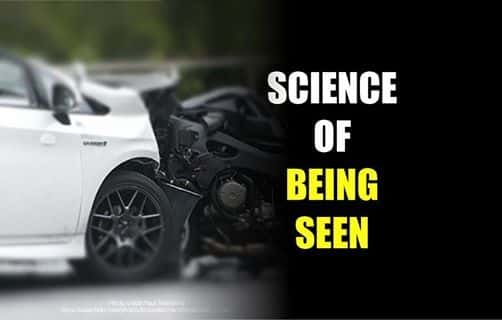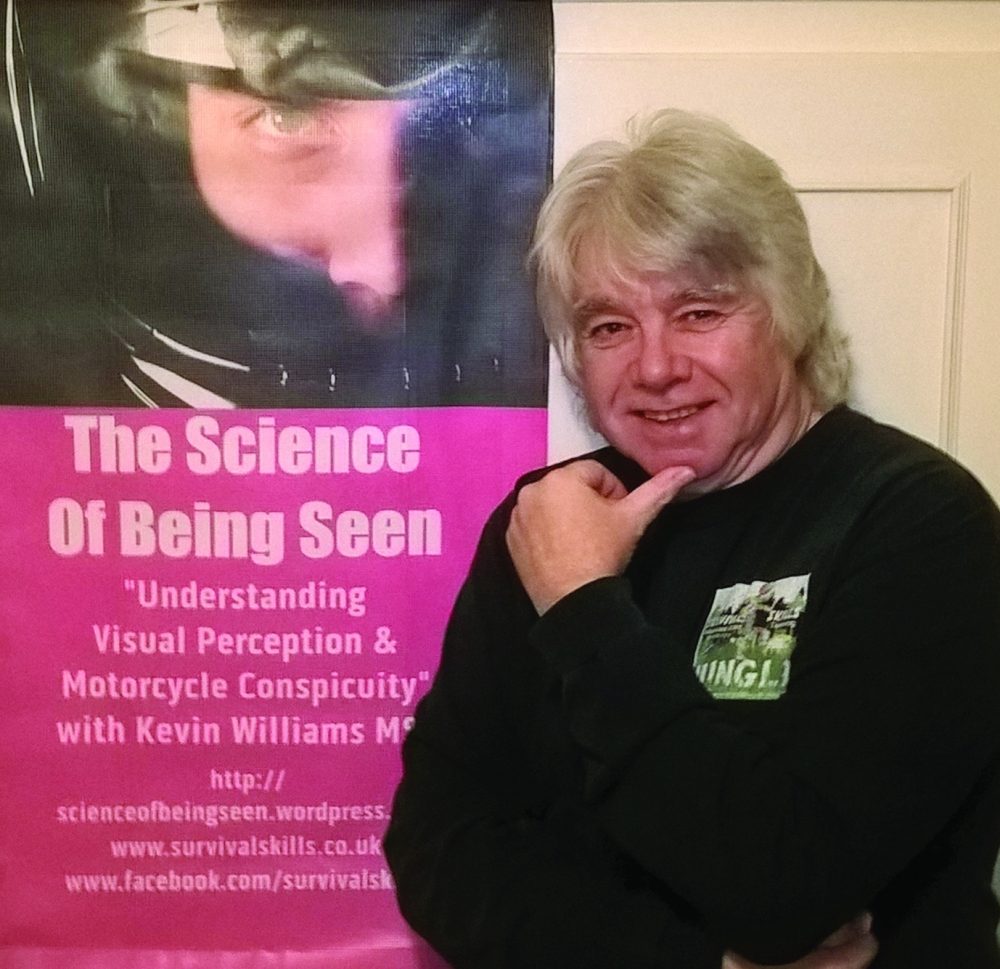Looked but FAILED TO SEE!
Last time out I began explaining how in around one-third of all collisions, the bike was in a place the driver could have seen it but for some reason FAILED TO SEE the machine – a ‘detection error’ where the driver looked in the right place, but failed to identify the presence of a motorcycle in the moments before making his manoeuvre.
We need to look beyond ‘not looking properly’ as an explanation. Human visual perception isn’t ‘camera-perfect’ and it’s not true to say that “if it’s visible, and if you look hard enough, you’ll see it.”
Any illusionist or soldier knows that.
Motion camouflage
In the last article, I mentioned that we have some ability to detect light / dark contrast as well as sudden bright stimuli and movement in peripheral vision. Anything that gets our attention is called an ‘attractant’ because it automatically results in our eyes moving to focus on whatever caught our attention – and at that point (and not before) it pops into our consciousness. That’s when we ‘see’ the object.
The problem is that it’s LATERAL movement that we are sensitive to – that is, ACROSS the background.
Movement directly TOWARDS the viewer is much more difficult to pick up. It’s well-known – I was aware of the issue from my science degrees – that hunting animals stalking prey will approach along a line that keeps them motionless relative to the background from the perspective of the prey animal. If the prey animal moves, the hunter subtly adjusts their own path so that they stay on the same relative bearing. This is how big cats and dragonflies operate, and they are exploiting the phenomenon known as ‘motion camouflage’. The only clue to movement is that the apparent size of the hunting animal increases as it gets closer, but it can get remarkably close before it gets so ‘big’ that it suddenly dominates the background. At that point, the hunting animal is finally detected – this phenomenon is known as ‘looming’.
Think about the typical motion of a motorcycle, riding along a straight road and approaching a stationary driver waiting to turn at a junction – the most common collision of all. It cannot be seen moving across the background.
With no lateral movement, we are also motion camouflaged.
And now there’s a significant risk that a driver will fail to detect our approach until we’re right on top of him / her when we ‘loom’ into view by filling the background.
You can check this out for yourself on YouTube. Watch this:
https://www.youtube.com/watch?v=4iOoiEbtf2w
(PS – keep the volume down if necessary – there are some expletives!)
Even though we can hear the Spitfire’s engine, we cannot see it against the background for two reasons:
:: our eyes are focused on the presenter, so the plane is initially in peripheral vision
:: even when the camera shifts, giving us a hint where to look, there is no lateral movement to help us detect the plane – it’s motion-camouflaged.
It is not until the plane is almost on top of us that we see it – a Spitfire is a LOT bigger than a motorcycle.
Saccadic masking
Here’s another issue. When we’re scanning left and right, we need to shift our eyes. But there’s a problem. This movement of the background is known to cause disorientation and dizziness.
So as we scan across a scene, we don’t move our gaze smoothly across the background although that’s what most of us think happens, and what most books on riding and driving imply we should be doing.
Our eyes don’t behave like a movie camera panning across the scene but work in a completely different way, much more like a still camera taking a series of snapshots of different parts of the view. Our eyes move in a series of jerks, pausing on one particular area – a ‘fixation’ – before moving very rapidly to the next. Then they move on again… and again… and so on.
The movements between the fixations are called saccades but unbeknownst to us, the brain ceases to process retinal images during these saccades. This is known as ‘saccadic masking’ or ‘saccadic suppression’.
Once again, this phenomenon has been known about for a very long time. It’s even exploited by dancers during fast turns – the dancer turns the body but ‘spots’ on a fixed location, then turns the head faster to catch up. Saccadic masking kicks in as the background blurs through the vision, helping maintain balance and prevent dizziness.
And now you can see why when we look left and right saccadic masking shuts down the visual processing system as our eyes move. Rather than ‘scanning’ right through the visual scene as we think we do (and as we’re told we should), it’s only where the eyes stop on an object of interest, in a stationary fixation (remember that from last time?) that we get a visual ‘snapshot’ that the brain can actually process. So rather than a ‘movie’, we get that series of snapshots interspersed by blank gaps.
But – just like the dancers – we are unaware of the shut-down and believe we have searched the entire scene because the brain synthesizes the missing visual data to give the impression of a continuous scan. Only if we are ALREADY tracking a moving object are we able to follow it without saccades.
Saccadic masking isn’t ‘carelessness’ or ‘failing to look properly’, it’s a fundamental limitation of – and a visual illusion created by – the human visual system.
There’s a second, but interlinked problem. As humans we learn. It’s a fundamental part of being human. And our learning often involves discovering shorter, quicker and most importantly, less energy-intense ways of doing something. At junctions, we’re always told to “look for vehicles” before turning. But it turns out to be an ineffective strategy, because if we look for vehicles, all we see are vehicles…
…and what we actually need if we’re to make the turning manoeuvre is empty space between those vehicles. So we discover very quickly – perhaps within half an hour of beginning to drive – that what we need to spot GAPS.
Now, remember the issues I mentioned last time – the narrow foveal vision cone, and the depth of field. There’s not just the possibility that a driver will look BEYOND the motorcycle, but a real risk that in turning the head to look both ways, the bike will be ‘blanked out’ by a saccade.
It’s worth pointing out that exactly the same issue can happen to bikers. There’s some evidence from countries with a lot of powered two-wheelers that suggests riders pull out in front of other bikes equally as often as drivers! So an attentive driver – or motorcyclist – can look both ways and yet fail to see an approaching vehicle.
How can we overcome this problem? Slowing down the head-turn doesn’t eliminate fixations and saccades but it does narrow the blank gaps and offer a better chance of a fixation landing the eyes on the bike.
Kevin Williams / Survival Skills Rider Training www.survivalskills.co.uk
(c) K Williams 2020
The Science Of Being Seen – the book of the presentation £9.99 plus P&P and available now from: www.lulu.com
The ‘Science Of Being Seen’ is a presentation created in 2011 for Kent Fire and Rescue’s ‘Biker Down’ course by Kevin Williams. Biker Down is now offered by over half the nation’s FRSs as well as the UK military, and many deliver a version of SOBS. Kevin personally presents SOBS once a month for KFRS in Rochester. He toured New Zealand in February 2018 delivering SOBS on the nationwide Shiny Side Up Tour 2018 on behalf of the New Zealand Department of Transport.
Find out more here: https://scienceofbeingseen/wordpress.com


